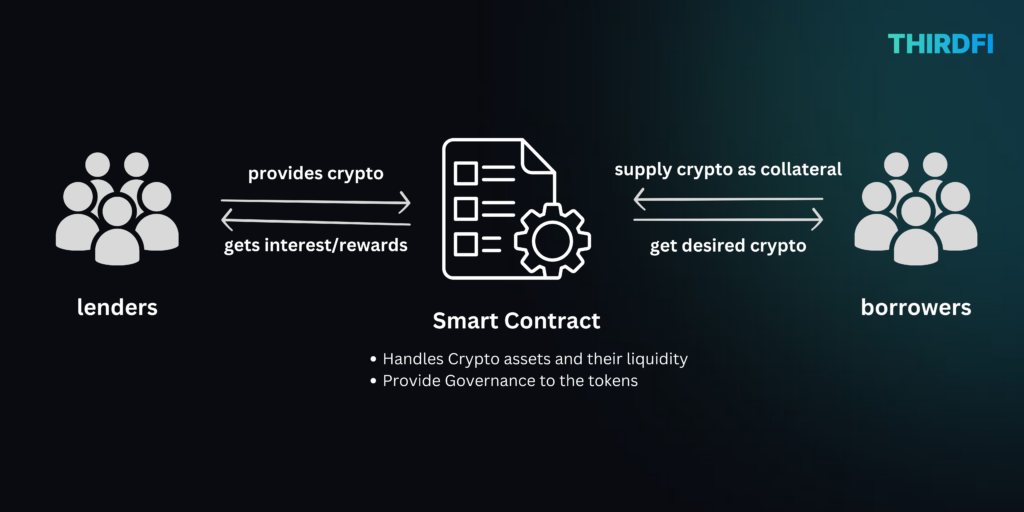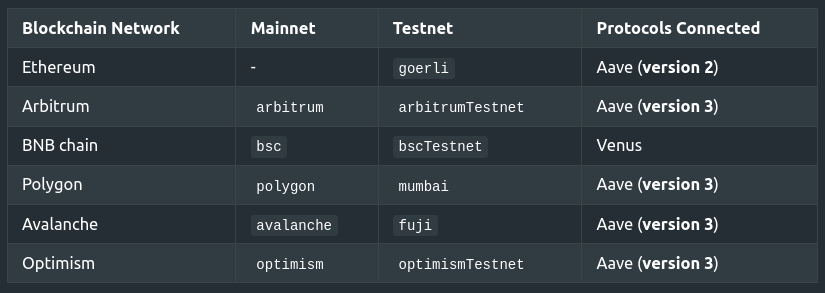Decentralised Borrow and Lending
May 9, 2023
Written by Ankit Singh
Borrowing and lending are financial activities in which one party provides funds to another party, typically with the expectation of receiving interest or other benefits in return.
Borrowing involves obtaining funds from a lender with the agreement to repay the borrowed amount along with interest over a specified period of time. This can be done for personal or business purposes, such as purchasing a home or expanding a company.
Lending, on the other hand, involves providing funds to a borrower with the expectation of receiving interest or other benefits in return. Lenders can be individuals, banks, or other financial institutions, and they often lend money to borrowers for various reasons, such as buying a car or starting a business.
Decentralised Borrow and Lending
Borrowing Protocol
The borrowing protocol allows users to borrow funds from the platform using their crypto assets as collateral. The amount of collateral required is determined by the platform and is based on the risk associated with the asset being used as collateral. The interest rates charged on borrowed funds vary based on the amount borrowed and the duration of the loan. Below are some reasons for which a developer/user can borrow assets.
- Leverage: Borrowing allows users to gain exposure to additional assets without selling their existing holdings. They can use the borrowed assets to invest in other opportunities, potentially amplifying their returns.
- Liquidity: Borrowing can provide users with additional liquidity to manage short-term cash flow needs or to take advantage of new investment opportunities without having to liquidate their long-term holdings.
- Yield farming: Borrow functions enable users to participate in yield farming strategies, where they can borrow assets, use them to provide liquidity to other protocols or platforms, and earn additional rewards or yield.
- Short selling: Users can borrow assets they believe will decrease in value, sell them in the market, and later repurchase them at a lower price to repay the loan, profiting from the difference.
- Arbitrage: Borrowing can facilitate arbitrage opportunities, where users can take advantage of price differences between different markets or platforms by borrowing assets on one platform and selling them on another.
Lending Protocol
The lending protocol allows users to lend their crypto assets to other users on the platform. The interest rates offered to lenders vary based on the amount of assets being lent and the duration of the loan. The platform charges a small fee on the interest earned by lenders. Below are some reasons why a developer/user can lend assets.
- Passive income: Lending assets in DeFi protocols like Aave and Venus allow users to earn passive income in the form of interest. Users can capitalize on their idle assets by supplying them to the protocol and receiving interest payments over time.
- Collateralization: Supplying assets to the protocol can enable users to access borrowing or other features offered by the platform. For example, users may need to supply collateral to the protocol to borrow other assets, mint stablecoins, or participate in yield farming strategies.
- Risk management: Lending assets in DeFi protocols can be a relatively low-risk investment strategy compared to more speculative activities such as trading or participating in highly leveraged positions. By lending their assets, users can earn a steady return while maintaining exposure to their original investment.
- Asset diversification: By lending assets to Aave or Venus, users may receive interest-bearing tokens (e.g., aTokens in Aave) that are pegged to the value of the underlying asset. These tokens can be used for additional investment or risk management strategies, providing users with more options to diversify their portfolio.
Difference Between Borrow and Lending
The key difference between the borrowing and lending protocols is the role of the user. In the borrowing protocol, the user is the borrower, while in the lending protocol, the user is the lender. Additionally, the interest rates charged on borrowed funds and the interest rates offered to lenders are different, and the amount of collateral required for borrowing is different from the amount of assets required for lending.
In Decentralised Finance, both Borrowers and Lenders are users of the Non-Custodial Liquidity Markets. The borrowers have to pay the interest and Lenders get the rewards(interest on their crypto). Here Risk management and governance is done by the Protocol.

Features Integrated into ThirdFi
- Get all the current token asset pools for borrowing and lending
- Get the user position of the pools by wallet address
- Get account unclaimed rewards
- Lend with a token asset
- Lending and borrowing with a token asset in one-click
- Borrow with a token asset
- Repay for borrowing an asset
- Withdraw lending asset
- Repay and withdraw in one-click
- Claim rewards
How to integrate these protocols into your DApps
ThirdFi’s Borrow & Lend API is a REST API that can be easily integrated into any platform or application. The API provides a developer-friendly interface with documentation and SDKs for easy integration. With ThirdFi’s API, developers, fintech, and traditional finance companies can easily provide DeFi solutions to their users without having to develop and maintain their infrastructure. The API’s integrated features provide a complete solution for borrowing and lending in the DeFi ecosystem.
Lending with ThirdFi
By providing lend (supply) functions in ThirdFi’s API, developers can build applications that leverage the lending capabilities of Aave and Venus protocols, enabling users to access these opportunities and strategies with ease. This allows for the creation of innovative and user-friendly platforms that cater to the growing demand for DeFi lending services, while simultaneously simplifying the process of integrating these powerful DeFi protocols into existing or new applications.
Borrowing with ThirdFi
With ThirdFi’s Borrow API integration, developers can offer their users powerful borrowing functionalities, including access to all current token asset pools for borrowing, getting the user position of the pools by wallet address, and access to unclaimed rewards. Developers can also enable users to borrow and repay an asset in one click, making the borrowing experience quick and easy.
You can get the list of supported pools here.

Possible Use Case
Below are some use cases that can be achieved by using ThirdFi API.
Automated Trading Bots: Developers can use ThirdFi’s API to build automated trading bots that can borrow assets and earn interest, as well as repay loans and withdraw assets automatically. This can help traders to maximize their profits while minimizing their risks, as the bots can execute trades in real time based on market data and user-defined parameters.
Collateralized Loans: Users can use ThirdFi’s API to take out loans with collateral, which can help them to access liquidity without selling their assets. For example, a user could borrow USDT by pledging ETH as collateral, and then repay the loan with interest at a later date. This can be particularly useful for traders who need short-term funding for their trading activities.
Yield Farming: ThirdFi’s API allows users to earn yield by lending their assets to liquidity pools. Users can earn interest on their assets in real-time, which can help them to generate passive income. Additionally, users can claim unclaimed rewards from liquidity pools using ThirdFi’s API, which can further increase their yield.
Stablecoin Liquidity Provision: Users can use ThirdFi’s API to provide liquidity to stablecoin markets, which can help to stabilize the price of stablecoins and improve their liquidity. This can be particularly useful for traders who need access to stablecoins for their trading activities.
Cross-Chain Trading: ThirdFi’s API supports multiple blockchains, which can enable users to trade assets across different blockchains. For example, a user could borrow assets on one blockchain and trade them for assets on another blockchain, all using ThirdFi’s API. This can help to improve liquidity and reduce trading fees.
Margin Trading: ThirdFi’s API allows users to borrow assets on margin, which can enable them to increase their trading leverage and potentially earn higher profits. Users can borrow assets at a lower interest rate than they could through other lending platforms, which can help to reduce their borrowing costs.
